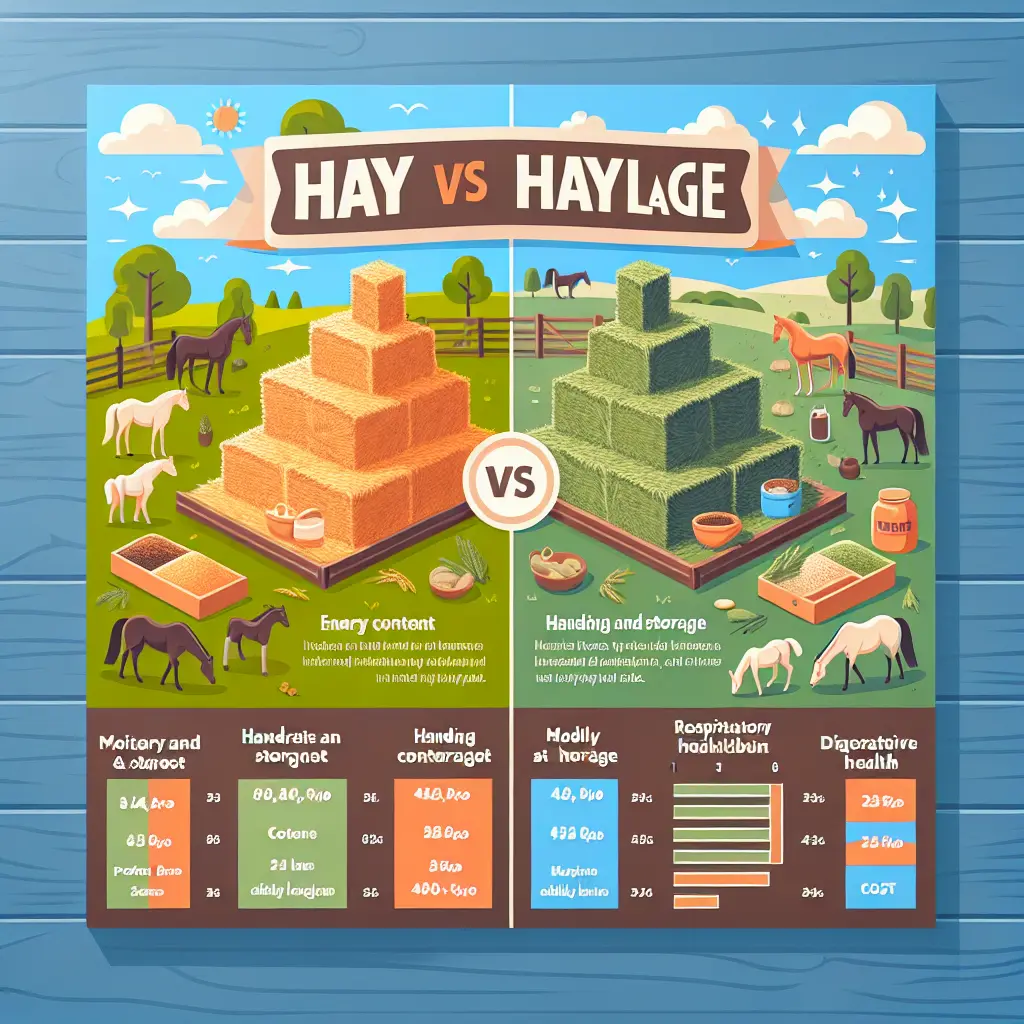Choosing Between Hay and Haylage: A Beginner's Journey in Equine Forage Management
When managing the diet of horses, one of the most crucial decisions horse owners face is choosing between hay and haylage as the primary forage. Both options have their own set of benefits and drawbacks, making it essential to understand their differences and decide based on the specific needs of your horse.
What is Hay?
Hay is made by drying grass to a high dry matter content (usually around 85-90%) to preserve it for long periods. This drying process can lead to some nutrient loss, resulting in hay being generally lower in energy and calories compared to haylage[1]. Hay is often the preferred choice for horses that don't require high energy levels, such as those at maintenance or in light work. It is also less expensive and easier to handle compared to haylage[3].

What is Haylage?
Haylage is produced by cutting the grass at a younger stage and allowing it to wilt before it is baled and wrapped in airtight conditions. This fermentation process preserves the forage, reduces sugar levels, and enhances nutrient retention[2]. Haylage is known for its higher digestible energy content, making it particularly suitable for horses in regular work or those requiring more calories. It also tends to be dust-free, which is beneficial for horses with respiratory issues[2][4].

Nutritional Differences
- Energy Content: Haylage generally has a higher digestible energy content than hay, making it more suitable for performance horses or young horses in growth stages[2][4].
- Sugar Levels: Haylage typically contains lower sugar levels than hay due to the fermentation process, which converts sugars into lactic acid and volatile fatty acids. This makes it a better option for horses prone to laminitis or metabolic issues[3][4].
- Protein Content: Haylage often contains more protein than hay, contributing to its higher nutritional value[3][4].

Practical Considerations
- Moisture Content: Hay has a much higher dry matter content than haylage, meaning less volume is needed to meet a horse's fiber requirements. However, haylage's higher moisture can make it more palatable and easier to digest[1].
- Handling and Storage: Haylage requires specific storage conditions to prevent spoilage and is generally more difficult to handle due to its larger size and weight. Hay, being lighter and drier, is easier to manage and store[3].
- Cost: Hay tends to be less expensive than haylage, but the latter's higher nutritional value may reduce the need for additional concentrates in a horse's diet[4].

Health Considerations
- Respiratory Health: Hay can accumulate dust and mold, posing risks to horses with respiratory conditions. Haylage is generally dust-free, making it a safer choice for such horses[2][4].
- Digestive Health: The fermentation process in haylage can aid digestion, but it may also lead to a higher risk of spoilage if not stored properly[1].
Choosing the Right Option
When deciding between hay and haylage, consider your horse's age, weight, condition, and level of work:
- For Horses in High Work: Haylage is often preferred due to its higher energy content and nutritional value[4].
- For Horses in Light Work or at Maintenance: Hay can be sufficient as it is lower in calories and less expensive[3].
- For Horses with Respiratory Issues: Haylage is generally preferred due to its dust-free nature[4].
- For Horses with Metabolic Issues: The lower sugar levels in haylage make it a better choice[3][4].
Ultimately, every horse is unique, and what works best will depend on specific needs and circumstances. Consult with a veterinarian or equine nutritionist to tailor your horse's diet effectively.
Additional Tips
- Quality Control: When purchasing either hay or haylage, ensure it is of high quality and free from mold. For haylage, check the wrapping and look for signs of spoilage[4].
- Mixing Forages: Some owners choose to mix different types of hay and haylage to balance their horse's diet and cater to individual needs[1].
In conclusion, choosing between hay and haylage requires careful consideration of your horse's requirements, including energy needs, health conditions, and personal preferences. By understanding the differences between these two forages and seeking professional advice when needed, you can provide your horse with the best possible diet.
Don't forget to check out the Jodhpur Collection, our wonderful Horse Riding Boot Collection, or the comprehensive selection of Horse Riding Gloves and Horse Riding Socks. Enhance your horse's gear with our Horse Treats And Gifts, along with Everyday Horse Vitamins & Supplements. Keep your horses cozy with our extensive Stable Rugs and Turnout Rugs. Protect them from pesky flies with our specialized Horse Fly Protection solutions.

